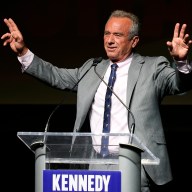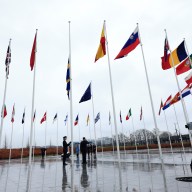 Arcade Fire are pictured here performing on the Reflektor tour earlier this summer.
Arcade Fire are pictured here performing on the Reflektor tour earlier this summer.
CREDIT: Ian Gavan/Getty Images
Moving Past the Feeling (Or, A personal account why I was — and still am — so moved by Arcade Fire)
When I moved to Prospect Heights, Brooklyn nearly a decade ago, I soon became aware that I was living in the epicenter of gentrification and development in the borough. I moved into a neighborhood that would rapidly change faces and façades, and I was by default among those thousands causing it, even though like many of its longtime residents, I also begrudged the idea of a sports arena breaking ground just blocks from my new apartment, on the corner where my new favorite dive bar stood. At the time, I wanted to live in “old Brooklyn,” a city that I’d constructed in my imagination naively based on television series like “The Cosby Show” and that looked very different form the one I landed in after abandoning the Florida suburbs. Somehow it didn’t matter then; I still optimistically clung to my ideals. And my soundtrack to that dying world that I was looking at through fresh eyes was an album thematically about growing up and that I listened to relentlessly, aptly called “Funeral.” I was the child that the Arcade Fire described in verse, holding my mistake up.
Nine years have passed — my first roommates have all escaped New York, the dive bar was demolished and I can no longer visualize what it once was that the Barclays Center arena replaced — but two things haven’t changed; I still call Prospect Heights home and I still tear up (with bittersweet longing for a lost time? With awe at how far I’ve come?) when I listen to Arcade Fire. I never thought that I would be beaming with joy while mouthing the lyrics to “Neighborhood #1” — a song about the march of time — inside an arena I’d once opposed being built in my neighborhood, nor did I imagine myself among those filling the cold space between our energized bodies and the arena’s high ceiling with the wordless yet loaded chorus of “Wake Up.” I guess we all just have to adjust.
Stare if you like (Or, Why humans are, by design, the best stage installations)
“I don’t think it’s fair, I don’t think it’s right that your city has two f—ing basketball teams and our whole country only has one.”
— Win Butler, jokingly commenting on performing in New York City at a basketball venue
While Canada may not boast as many basketball teams as New York, Butler’s mates alone brought with them enough mascots to compensate, and they were far more entertaining than the Nets’ own Brooklyn Knight. Manpower, it turns out, serves as the best visual. The 13-member touring band multiplied over the course of a set that verged on two hours on two stages: a main stage flanked by clustered hexagonal screens airing a live feed of each member’s extraordinary musicianship and a secondary hydraulic platform opposite the main stage and hovering above the moat of floor seats in between them.
Mirror man (who, also faceless, could easily have been the Brooklyn Knight, just draped in a suit of silver mirror shards) emceed the band’s explosive launch into the show from his perch on the second stage. He returned to grand applause later in the show for “Afterlife,” when lights aimed at his amorphous figure in motion from all directions made him the only necessary set design fixture, refracting white beams in all directions of the arena’s cavernous blackness.
The band members themselves, too, became mascots, disguised by giant papier maché heads, but the best of the characters to rise up on stage two was a quartet of dancers, men with enviable calves, so chiseled you could have seen them from the steep upper level. In high-waisted, skin-tight shorts, tied-up flannel shirts and patent stiletto heels, their sharply articulated choreography to “We Exist” was mesmerizing, taking attention away from the band on the surface level and giving way to the commanding and impactful song itself. Although I confess that I hadn’t seen the Andrew Garfield music video for the track until after the show, I’m actually glad that I was caught off guard by the performance. Surprise is such a great tool for shifting the mood and momentum; if for none of the infinite other arguments I could make, to be surprised is the best reason to see the Arcade Fire live.
 Regine Chassagne, left and Win Butler are pictured here performing on the Reflektor tour earlier this month in California. CREDIT: Kevin Winter/Getty Images
Regine Chassagne, left and Win Butler are pictured here performing on the Reflektor tour earlier this month in California. CREDIT: Kevin Winter/Getty Images
Let it never be over (Or, A love letter to Régine Chassagne)
Arcade Fire masterfully maintained an engaging pace, kicking off with a bang, mellowing out — Win Butler’s mid-set a cappella solo performance of “My Body Is a Cage” was both understated and arguably his best onstage moment — and then returning to anthemic proportions, the lights pulsing in chorus with every exalting “hey” in “No Cars Go.”
But it was Régine Chassagne’s dynamic, spirited stage presence that dominated a four-song arc — “Haiti,” “Afterlife,” “It’s Never Over (Oh orpheus)” and finally “Sprawl II” (Mountains Beyond Mountains) — and brought the concert to its energetic peak, pre-encore.
For “It’s Never Over,” she rose from the second stage, facing the rest of the band from afar, tangled in the writhing bodies of dancers donning skeleton costumes. Chassagne and Butler’s voices, layered but removed, carried out a dialogue with a palpable sensuality crossing the arena. Back on the main stage to take the helm for “Sprawl II,” she playfully and triumphantly spanned its full width, weaving around her bandmates, waving rainbow streamers. Chassagne showed us that she was having as much fun performing as we were swaying and clapping in formidable unison. It was inspiring.
How you feelin’, Brooklyn? (Or, Why I plan to one day to hire Arcade Fire to play my wedding reception)
I would never have expected an Arcade Fire concert to erupt into a dance party, but then, I would never have expected the band’s choice for an encore guest star: Buster Poindexter (AKA New York Dolls frontman David Johansen).
Once my initial shock — “Wait, what?” — abated, it occurred to me that the band’s cover of “Hot Hot Hot” was perfectly apropos to both the city and to Reflektor’s Caribbean influences.
The resulting fiesta — and flawless lead the into the steel drum (via keyboard) backbeat of “Here Comes the Night Time” — was not only memorable, but maybe even deserving of genius status. If you don’t take my word for it, here’s a selection of related fan tweets:
@spak: “Buster Poindexter takes the stage 2 perform #HotHotHot & Arcade Fire concert just became my bar mitzvah #CongaLine
@MaraHennessey: Is #busterpoindexter @arcadefire responsible for the demise of #hipster irony? Let’s hope so! We had a ball tonight
@alexrappaport: Buster Poindexter on stage with @arcadefire marks the official end of the hipster era. Irony overload. #Barclays #brooklyn #brilliant”
Ultimately, the only lingering disappointment I feel after Arcade Fire’s epic encore Friday night is that I will sadly be missing the surprises they have in store for their Saturday and Sunday night audiences. Like many of those (truly lucky) ticket-holders, I grew up with Arcade Fire; their four full-length albums have musically accompanied me though majors shifts in my adult life. But the vivacity and humor with which they played Friday was a reminder, in the face of change and passing time, to embrace the children we all will always be.
















